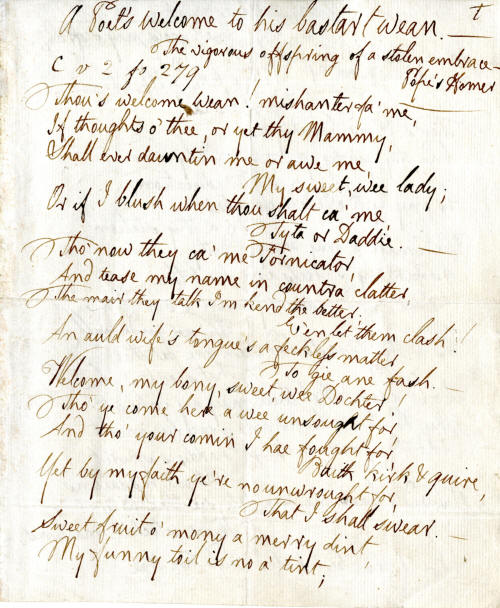|
Edited
by Frank R. Shaw, FSA Scot, Dawsonville, GA, USA
Email:
jurascot@earthlink.net
I am
fortunate to have on my bookshelves most of the series of Ross Roy’s
Studies in Scottish Literature and its subsequent
reprints. They are a constant source of reference on the works of Robert
Burns and are a treasure trove of writings pertaining to almost all things
Scottish, men and matters. Volume XXX is dedicated solely to the study of
Robert Burns. Then there is a double issue, Volumes XXXV – XXXVI, which has
special meaning to Susan and me. The following is inscribed in my copy: “For
Frank and Susan in appreciation of all they have done for Scottish
literature at the University of South Carolina and as a token of friendship
between the four of us. Ross” (4.22.08). The four include Ross’s charming
and lovely wife Lucie, who served faithfully as Associate Editor of the
series.
It is heart
warming to know that these volumes are being readied for worldwide internet
use to aid future generations, and it’s good to know that Ross will be
continuing in an advisory capacity. I understand that when he decided many
years ago to publish Studies in Scottish Literature, someone remarked
Ross would have a hard time filling one volume. That was nearly five decades
ago, and the volumes keep coming.
Today’s
article began just this morning with an email from Patrick Scott regarding
the future of the series. In rapid-fire response to my suggestion that the
contents of his email be made public through the pages of Robert Burns
Lives!, Patrick has shared the following update for our readers. (FRS:
9-20-12)
The New Studies in Scottish Literature Goes Digital
(and keeps print)
By Patrick Scott
For nearly
fifty years Ross Roy’s journal Studies in Scottish Literature has
been an essential resource, not only on Robert Burns but on the whole range
of Scottish writers. A lot of people were saddened when he announced in a
huge double volume as he neared his 85th birthday that it was to
be the last full volume, to be followed only by a cumulative index to the 36
volumes he had edited since founding the journal in 1963. “At that time,” he
writes in a preface to this new volume, “I truly believed that the journal,
which I had nursed from its infancy, was to end.”

The SSL lion, the journal’s logo during Ross Roy’s editorship
Happily, he
decided to change his mind, donating rights in the journal to the University
of South Carolina Libraries, so it could continue. This week, the first of
the new volumes went online at
http://scholarcommons.sc.edu/ssl/, though the journal will continue also
to be issued in print form.
Ross asked
me to take on editing the journal from this volume on, and I have been lucky
to recruit my South Carolina colleague Tony Jarrells to edit it with me.
Ross is continuing in an advisory role as Founding Editor, and an expanded
international advisory board features a lot of names well known on Robert
Burns Lives!, including Ken Simpson, Gerard Carruthers, Robert Crawford,
and Murray Pittock.
The new
volume includes four items of direct Burns interest. An important
full-length article by Stephen Brown argues that the original printer of
The Merry Muses of Caledonia was Alexander Smellie, son of Burns’s
friend William Smellie, and supports the argument by including photos of the
watermarks in the paper of the Merry Muses and of another book
Smellie printed at the same time.
An article
by Marvin McAlister discusses the way Burns’s poem Scots wha hae, with its
call for resistance to slavery, was used on the African-American stage in
Harlem in the 1820s.
Ross Roy
contributes commentary on the poem Burns addressed to his first-born child,
to introduce a full facsimile of a previously-unrecorded manuscript of the
poem in Burns’s hand. Because it is online, you can enlarge the facsimile
to examine Burns’s handwriting close up. With the facsimile, I’ve provided
details on the history of the manuscript, which was acquired for the Roy
Collection last year.

The first page of the Robert Burns manuscript
The fourth
and briefest item is a four-page note about the only letter Robert Burns
wrote to his uncle Samuel Brown, at the time he was settling down to
marriage and the farm at Ellisland, reporting a much earlier printed source
for a letter where no manuscript source can now be located, though two were
recorded by earlier editors.
A new
feature is an opening symposium, with a number of authors contributing
different viewpoints on a single topic. This year’s symposium, on the
Present State of Scottish Literary Studies, echoes a sharp debate in the
very first volume of the journal that Ross Roy edited fifty years ago.
Contributors this time round include Murray Pittock, Gerard Carruthers,
Leith Davis, Matthew Wickman, Willy Maley, and Caroline McCracken-Flesher
(who has a fascinating piece on “Digital Scotlands” that includes a live
link to a Scottish Television clip about two Glaswegians trapped in an
elevator with American voice-recognition controls: see the clip, and if you
need it, the article gives a helpful transcription of what is being said).
When Ross
transferred the journal, he also donated rights in past volumes to the
University of South Carolina Libraries. The journal site now also includes
free searchable access to earlier volumes; currently available are volumes
13-34 (1977-2004), and further volumes will be added over time. This part of
the site was launched about a month ago and is already proving useful to a
lot of users who haven’t had easy access to the older volumes. Many smaller
college libraries have never had the journal. It also makes a fantastic
on-line resource for Scottish high school students, who now have to answer a
question about Scottish literature in their leaving exam.
The journal
volumes will continue to be available in print format to subscribers and for
purchase. Previous subscribers will be contacted shortly about their wishes
when the new print volume is available.
Plans are
already underway for next year’s volume, which will include at least one
further Burns discovery, and a symposium on the special issues in editing
Scottish literary texts, unscrambling or investigating how the writers’
language is altered by successive stages of the publication and editing
process.
The purpose
and scope of the journal, however, remain the ones that Ross Roy laid out
nearly fifty years ago:
Studies in Scottish Literature
was founded with the idea of creating a common meeting
ground for work embracing all aspects of the great Scottish literary
heritage. It is not the organ of any school or faction; it welcomes all
shades of opinion. . . . As a journal devoted to a vigorous living
literature it will carry articles on contemporary authors (SSL vol.
1, p. 3).
What has changed is that now, in addition to the
print volumes in libraries worldwide, we can also make the journal
accessible in so many new ways as well and to so many new readers (as
Robert Burns Lives! has been showing so effectively.) |

